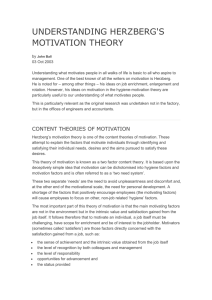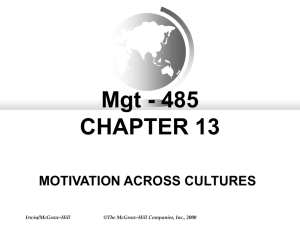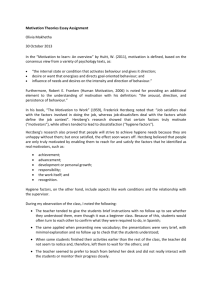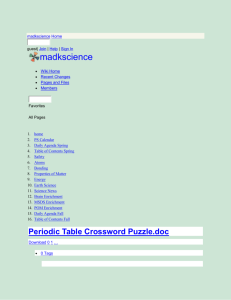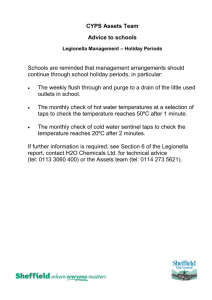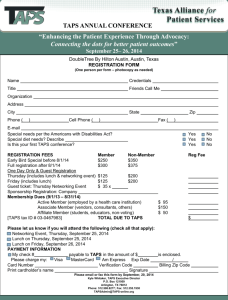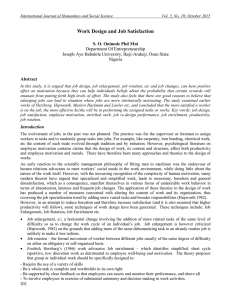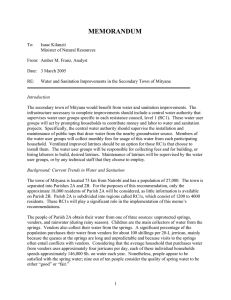Motivation Theories
advertisement
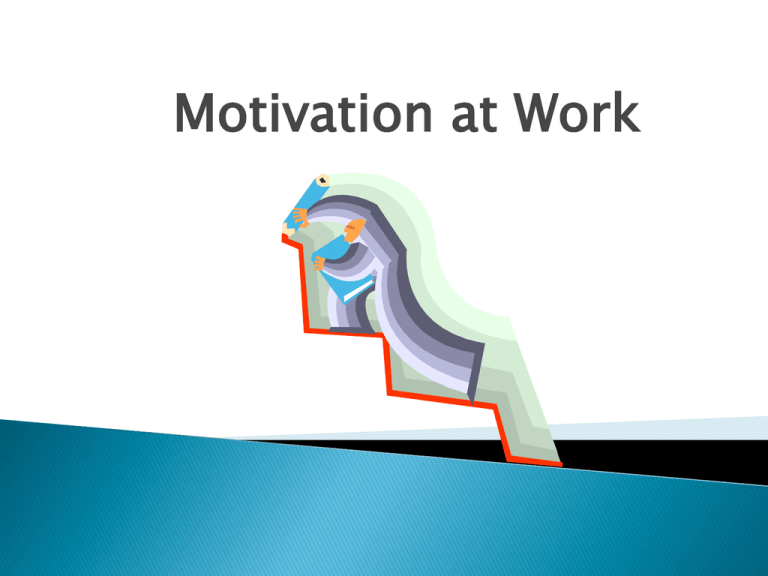
Motivation at Work Scientific Management Bureaucratic Management Human Relations Era Need Theories Goal Orientation Motivator-Hygiene Theory Job Enrichment Scientific Management (Frederick Taylor) ◦ Objective is to improve the productivity of the individual worker Develop a science for each aspect of individual’s job ◦ Find the one best way to perform a task Time & motion studies “Science of shoveling” ◦ Motivate employees through $$ Standard amount of production is set Going above the standard earns you more money Bureaucratic Management (Max Weber) ◦ In an industrialized economy, how can we manage organizational growth & size? ◦ How can we make sure the overall system is supporting the organization's goals? Reduce opportunities for individuals to take advantage of organization Human Relations & Behavioral Era ◦ Hawthorne Studies Human behavior is not necessarily “rational” Employee needs & attitudes influence behavior Soliciting employee opinions contributes to feeling of importance and can lead one to work harder ◦ Maslow, Herzberg, Hackman & Oldham What is the secret of The Container Store’s success? What does The Container Store do that sets it apart from other companies? What evidence is provided by The Container Store’s success that organizational behavior is an important element in employee productivity and organizational profitability? What is it? Why is it important? Can you influence the level of work motivation in your employees? ◦ How? ◦ What approaches can be considered? Motivation – the process of arousing and sustaining goal-directed behavior The Person ◦ Human Needs ◦ Theory X and Y ◦ Liking of the task The Environment ◦ ◦ ◦ ◦ Enriched Job Tasks Goal setting interventions Leader behavior Group Norms and Organizational Culture SA Esteem Love (Social) Safety and Security Physiological Need for Achievement –need for excellence, competition, challenging goals, persistence, and overcoming difficulties Need for Power – need to influence others, change people or events, and make a difference in life Need for Affiliation - need for warm, close, intimate relationships with others What employee needs is SAS Institute meeting with their policies and practices? Why does meeting these needs foster employee motivation? Complete the motivation style self assessment – 10 minutes Provide responses that are as honest as possible about how you approach job tasks Refers to the goals held by a trainee in a learning situation individuals in their work situation ◦ learning orientation – relates to trying to increase ability or competence in a task ◦ performance orientation – refers to a focus of learners on task performance and how they compare to others ◦ Avoid goals ◦ Prove goals Learning Goal orientation is associated with the highest performance Motivation–Hygiene Theory of Motivation • Company policy and administration • Supervision • Interpersonal relations • Working conditions • Salary • Status • Security Hygiene factors avoid job dissatisfaction Motivation factors increase job satisfaction • • • • • • Achievement Achievement recognition Work itself Responsibility Advancement Growth • Salary? KITA versus “true” motivation ◦ Short-term movement versus long-term motivation Job enrichment is an attempt to instill an internal generator in the employee Studies of Herzberg’s theory have included employees working in a variety of industries and jobs ◦ Accountants, engineers, nurses, military officers, and others Motivators ◦ Tap needs for psychological growth ◦ Job content: The work itself ◦ Lead to high levels of employee motivation and satisfaction Examples ◦ ◦ ◦ ◦ Recognition Responsibility Achievement Growth and learning Job Enrichment – designing or redesigning jobs by incorporating motivational factors into them Job Enrichment Emphasis on • Recognition • Responsibility • Advancement opportunity Removing some controls & retain accountability ◦ Reduce the percentage of proofreading Taps responsibility & achievement Increasing employee accountability ◦ Subordinates sign their own work Taps responsibility & recognition Psychological ownership Enabling one to become a topic expert Taps achievement, responsibility, growth Competence Make organizational reports available to all ◦ Revenue, expenses, projections, trends, customer satisfaction reports Taps responsibility, recognition, growth Employees are internally motivated (internal generator) versus externally moved ◦ Enriching jobs (Motivators) can be significantly less expensive in comparison to hygiene ◦ Supervisors can focus more on the future (planning) as opposed to the past (checking work) Expect initial drop in quantity of work, followed by increase in quantity and quality. Why is Starbuck’s such a successful company? What does Starbuck’s do that is motivating to employees? What do Starbucks, SAS Institute and the Container Store have in common? Using the following motivation theories, analyze what makes these three companies successful: ◦ Need Theory ◦ Herzberg’s Motivator-Hygiene Theory
